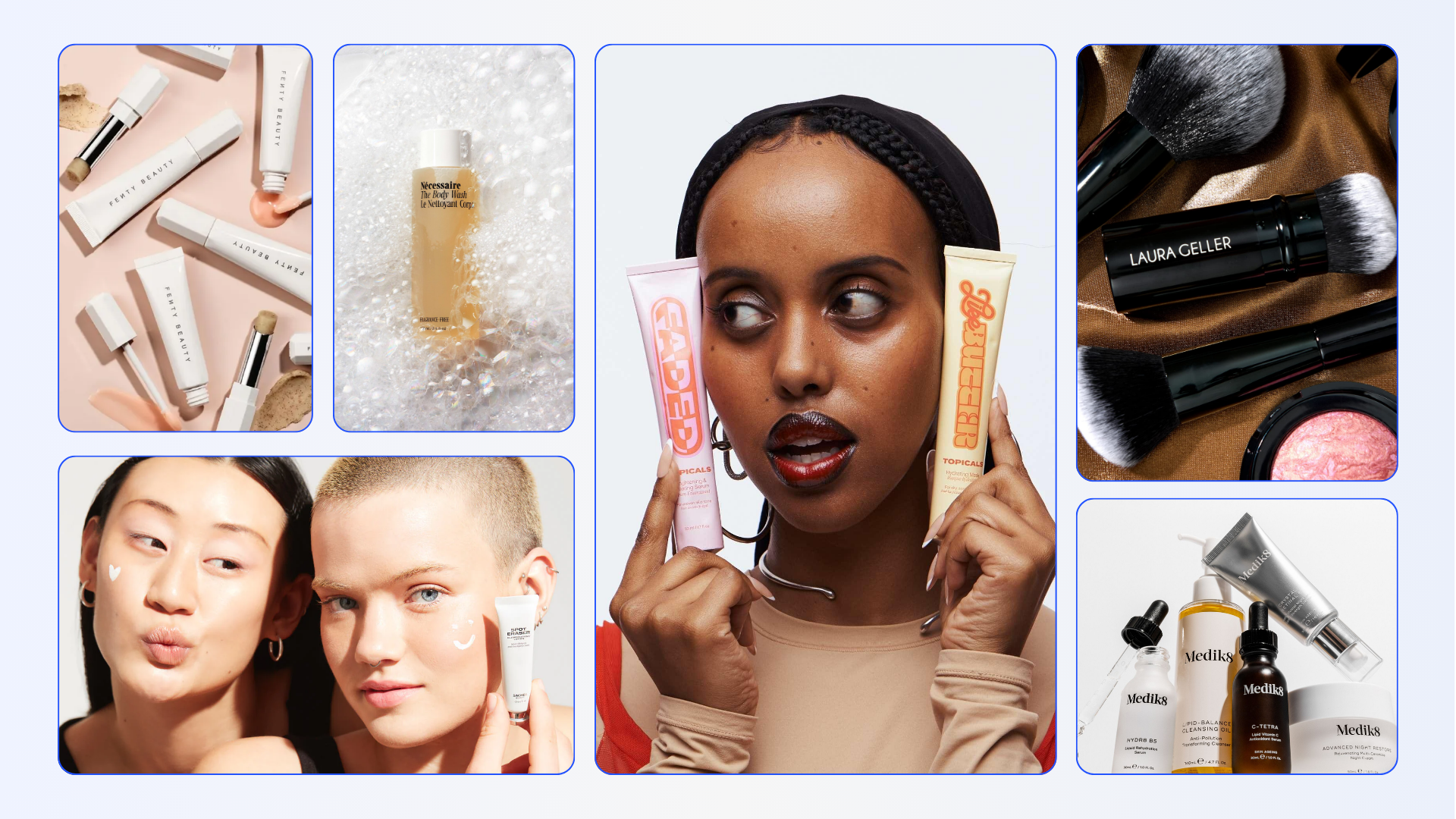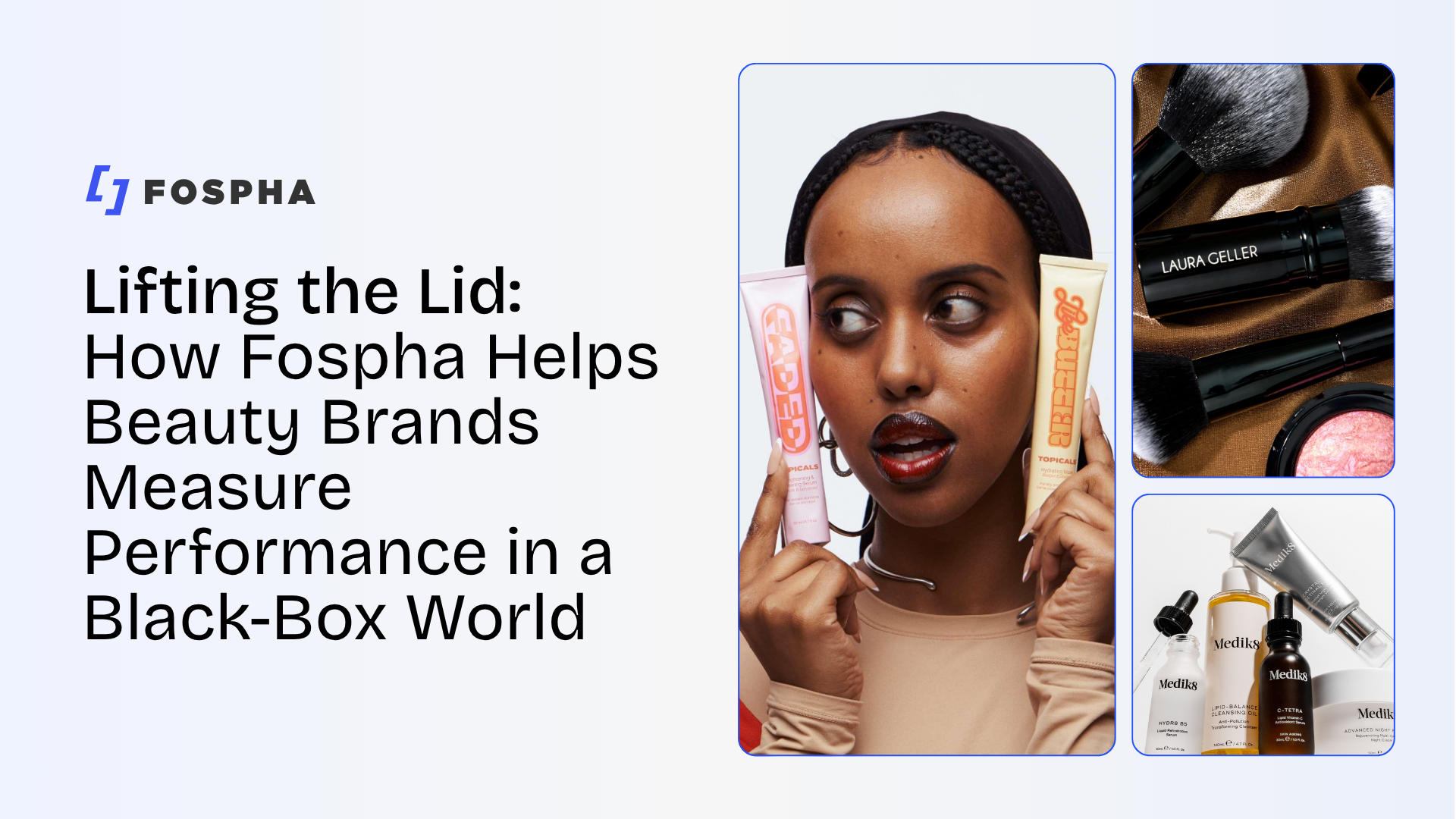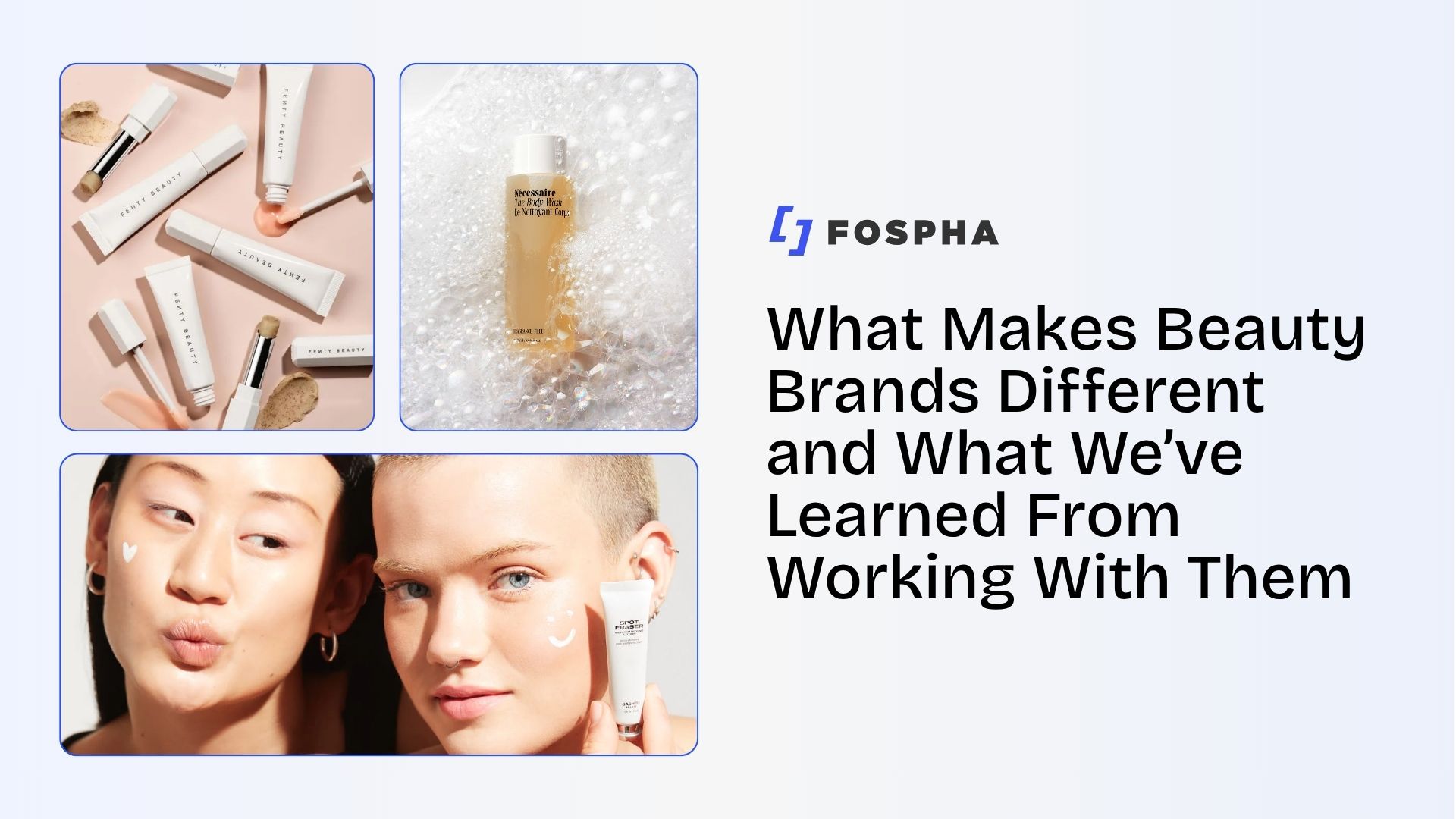Beyond the Checkout: Measuring the True Impact of Marketplaces for Beauty Brands
For beauty brands, Amazon and TikTok Shop influence far more revenue than the checkout data shows. The winning brands measure the full journey, how marketplace exposure drives discovery, demand, and conversion across every channel.

When Every Scroll Becomes a Storefront
The way people buy beauty has changed. Discovery now happens on TikTok; research happens on Amazon; purchase could happen anywhere. Yet for all this cross-channel movement, most beauty marketers still measure marketplaces through a single lens - the checkout.
That narrow view misses the bigger picture. When a TikTok creator goes viral, you might see a spike in branded search or Amazon traffic days later. When you invest in Amazon Sponsored Brands, you might see stronger DTC sales but no obvious lift in Amazon dashboards. The connection is real but invisible without the right measurement.
Fospha helps beauty brands move beyond the checkout, quantifying how marketplace exposure contributes to overall growth, not just in-platform orders.
.png)
Why Beauty Can’t Measure Marketplaces in Isolation
Few industries are as omnichannel as beauty. Shoppers blend inspiration, research, and purchase across multiple touchpoints and expect consistency wherever they encounter the brand.
A single buyer journey might look like this:
- A creator’s TikTok tutorial introduces a new serum.
- The shopper searches it on Amazon to compare reviews and prices.
- They end up buying from the brand’s site to access a loyalty offer.
Only the final transaction is visible in analytics, but all three steps influenced the decision.
Yet platform dashboards report each environment in isolation - Amazon measures Amazon, TikTok measures TikTok - leaving brands unable to see the cumulative impact. For beauty, this opacity is particularly costly because purchase decisions are emotional, repeatable, and driven by both storytelling and trust.
That’s where Fospha steps in. Its unified measurement captures the incremental effect of every marketplace impression - showing how exposure on one platform drives conversion elsewhere.
The Amazon Effect: The Beauty Counter for the Digital Age
Amazon is no longer just a retailer; it’s where beauty discovery begins. For many consumers, Amazon is the first stop in the decision-making process - the new “beauty counter” where reviews, ingredient lists, and brand storytelling all converge. It’s where trust is built long before a purchase takes place.
For beauty brands, this means Amazon’s impact extends far beyond the orders placed within its checkout. When a consumer clicks on an Amazon Sponsored Brand ad, reads reviews, and then completes the purchase on a DTC site or in-store, that entire journey is typically invisible in Amazon’s attribution model. The campaign appears to underperform, even though it played a crucial role in shaping the buyer’s decision.
Conventional last-click reporting gives Amazon credit only when a sale happens directly on the platform. But the reality is that Amazon ads drive substantial off-platform influence, shaping brand preference, improving search intent, and boosting conversions elsewhere. Fospha’s aggregated beauty category data (2025) shows that when brands model this cross-channel effect properly, Amazon’s true contribution to total revenue is often 20–30% higher than platform-reported metrics suggest.
This insight fundamentally changes how beauty marketers should think about Amazon. It’s not simply a lower-funnel conversion channel; it’s a full-funnel growth engine. It acts as a trust accelerator, one that nurtures awareness and consideration just as effectively as it drives purchase. Treating it as a siloed sales environment limits its potential. Treating it as an integral part of your marketing ecosystem unlocks its true power.
(Source: Fospha Beauty Measurement Insights, 2025)
Case Study: Nécessaire - Connecting Amazon to the Full-Funnel Picture
Few beauty brands embody this measurement shift better than Nécessaire. The premium body care brand faced a common challenge: understanding how digital demand channels like Meta and TikTok were influencing sales on Amazon, and how Amazon activity was feeding back into their broader marketing performance.
Traditional attribution left them with blind spots. Amazon’s walled-garden data meant Meta and TikTok appeared less efficient than they truly were, while Amazon’s reporting only credited in-platform sales. Nécessaire needed a unified view, one that showed the full impact of their marketing investment across DTC and Amazon simultaneously.
By implementing Fospha’s cross-channel measurement model, Nécessaire uncovered what had been hidden in plain sight. When Amazon performance was integrated into their measurement stack, Meta’s return on ad spend increased by 87%, and TikTok’s true ROAS nearly doubled. The data revealed how awareness and demand generated by social channels were driving significant Amazon revenue - previously unaccounted for in last-click models.
This new visibility transformed how the brand allocated budget. During Prime Day, Nécessaire saw 47% higher revenue than category benchmarks, and over 60% of sales came organically - clear proof that their upper-funnel demand channels were fuelling marketplace performance.
For beauty marketers, Nécessaire’s experience is a powerful lesson: you can’t measure Amazon in isolation, and you can’t evaluate demand channels without factoring in their marketplace impact. Only when those pieces come together do you see the complete growth picture - one that connects awareness, consideration, and conversion across every channel your customer touches.
.png)
The TikTok Shop Ripple Effect: From Discovery to Demand
Since its U.S. debut, TikTok Shop has become a powerhouse for beauty, now the eighth-largest beauty retailer in the country - just behind Ulta. Nearly 80% of TikTok Shop’s U.S. sales come from health and beauty, making it one of the most influential platforms in the category.
Beauty has thrived here because the platform is built for it: visual storytelling, creator trust, and impulse-driven shopping. Tutorials and “get-ready-with-me” content fuel discovery; low price points and replenishment cycles make conversion seamless. But as TikTok Shop expands, it exposes a major gap in measurement.
The Halo Effect Driving Marketplace Growth
TikTok is no longer just a social channel, it’s a full commerce ecosystem. Shoppers might see a product in a video, browse it on TikTok Shop, but ultimately complete their purchase on Amazon or a brand’s DTC site. Traditional attribution misses this entirely.
Fospha’s live “Halo” data reveals that TikTok Shop’s unified ROAS is 20% higher when Amazon sales are included. In other words, TikTok’s true impact extends well beyond in-app checkouts, driving discovery and demand that convert across multiple marketplaces.
When beauty content goes viral, brands see the ripple effect everywhere: Amazon searches rise, DTC traffic lifts, and Meta campaigns perform better. Yet TikTok’s native reporting gives that activity zero credit.
What Beauty Marketers Need to Know
- TikTok fuels multi-channel revenue. Awareness and creator content drive incremental sales on Amazon and beyond.
- In-platform metrics understate real performance. Measurement must include off-platform influence to reflect TikTok’s total value.
- Full-funnel visibility is non-negotiable. Marketers need unified models - like Fospha’s MMM - that quantify TikTok’s incremental impact across all sales environments.
For beauty brands, the takeaway is simple: you can’t measure TikTok Shop in isolation. Its influence extends across every commerce channel, shaping discovery, accelerating purchase intent, and amplifying marketplace performance.
TikTok isn’t just a media platform anymore. For beauty, it’s where storytelling meets measurable growth.
.png)
Measuring the Full Beauty Marketplace Journey
Connecting TikTok and Amazon performance requires more than a stitched-together spreadsheet. Fospha unifies data from marketplaces, paid media, and owned channels to isolate incremental lift, showing how TikTok impressions, Amazon ads, and Meta campaigns work together to drive revenue.
With this view, beauty marketers can finally answer the right questions:
- How much Amazon ad spend actually drives DTC sales?
- Which TikTok campaigns generate real incremental demand, not just clicks?
- How do I rebalance budgets to maximize growth across all marketplaces?
This is how leading beauty brands are moving from reactive to predictive, using Fospha’s always-on MMM to detect saturation, forecast returns, and uncover where incremental revenue really lies.
From Marketplace Metrics to Marketing Leadership
The beauty category is evolving fast and the biggest growth isn’t happening in DTC alone. It’s happening everywhere: across Amazon, TikTok Shop, YouTube Shopping, and beyond. Marketplaces have become the new front line of brand growth, redefining what “premium beauty” looks like and expanding how customers engage with products.
But this diversification brings complexity. When sales are spread across multiple commerce environments, a measurement system that only tracks website data will miss the majority of performance. It leaves beauty marketers blind to the full halo effect, where ads on TikTok boost Amazon sales, and Amazon ads increase DTC conversion.
Leading beauty brands are responding by modernising how they measure success. They’re moving from legacy last-click reporting to full-funnel, cross-channel measurement that connects upper-funnel exposure to bottom-line revenue. This shift ensures that awareness-driving activity - from influencer content to Sponsored Brand ads - is properly valued for its incremental impact.
The next generation of measurement leadership in beauty will rest on five pillars:
- Recognise and measure halo effects – quantify how awareness channels like Meta and TikTok drive sales across marketplaces and DTC.
- Treat marketplaces as enterprise growth engines – view Amazon and TikTok Shop not as silos, but as key components of total revenue strategy.
- Build multi-channel resilience – diversify across commerce and media to reduce dependence on any single platform.
- Retire legacy attribution – evolve beyond last-click or siloed dashboards to models that reflect true cross-channel influence.
- Invest in measurement literacy – empower teams across marketing, eCommerce, and finance to interpret and act on full-funnel data.
.png)
The message is clear: beauty’s competitive advantage in 2026 will come from mastering multi-marketplace strategy and measuring performance wherever the customer converts.
Brands that achieve this integration like Nécessaire and other marketplace leaders are already proving that connected measurement isn’t just about better reporting. It’s about smarter growth. They’re reallocating budgets with confidence, understanding halo effects in real time, and capturing value that others can’t see.
Because the future of beauty commerce isn’t defined by where people buy, it’s defined by how well brands measure the journey that gets them there.
Conclusion: Beyond the Checkout, Toward True Growth
Marketplaces have become the new battleground for beauty brands, but the scoreboard hasn’t caught up. Checkout data shows where revenue lands, not where it starts.
Fospha enables beauty marketers to see the full picture: how Amazon drives trust, how TikTok sparks discovery, and how each marketplace interaction contributes to total growth.
The brands that adopt this connected approach aren’t just optimizing performance; they’re future-proofing their marketing - making every impression, every creator, and every channel count toward real, measurable business impact.
Because in beauty, the sale may happen anywhere - but the influence happens everywhere.

Stay ahead with the inside scoop from Fospha.
For over 10 years we've been leading the change in marketing measurement.





